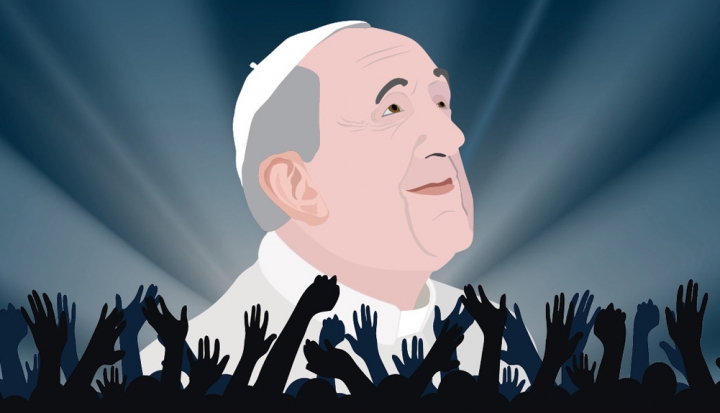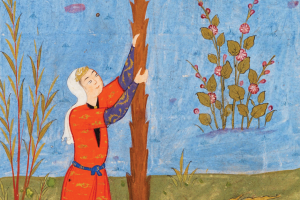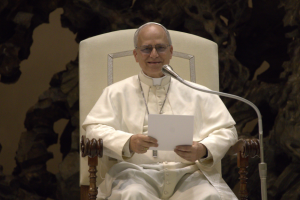While absent Catholics have not yet stampeded back to Mass, Pope Francis has rekindled interest in the church almost solely on the basis of his immensely attractive vision of how to live out the faith.
The Catholic community of St. John Fisher Parish erected what was to be a temporary worship space on the corner of Crest Road and Crenshaw Boulevard in Rancho Palos Verdes, California. The plan was to eventually convert the boxy building “behind a stone wall and row of dense tall pines” into a parish hall or gym, says pastoral associate Katherine Coolidge. That was more than a half-century ago.
The parish underwent an enormous change over the past several years as the community built a new worship space. Now on the corner stands a circular building with huge wing-like structures projecting from inside the walls of the church that seem to orient the building outward—unmistakably a church, despite its modern architecture, to anyone who happens by. The changes weren’t simply in building construction, though. “During this process, our understanding of who we are called to be underwent a huge transformation,” says Coolidge. “Once construction of the church began, we were no longer an enclave unto ourselves but a visible presence on the Palos Verdes Peninsula. This began to affect how we understood our mission.”
Coolidge’s assessment of the change in her parish is not unlike how some have come to view changes in the Catholic Church as a whole over the past year. Until recently, the church—if not quite an enclave unto itself—has at least appeared to be focused inward. Its emphasis has been on issues such as the new English translation of the liturgy and battles over religious freedom, showing a concern largely with doctrine and practice. And then came the election of Pope Francis.
Pope Benedict XVI’s resignation and the election of Cardinal Jorge Mario Bergoglio of Argentina as the church’s new pontiff happened just as the St. John Fisher community was working to revise its pastoral plan, a process that took more than a year. “It was as if this extraordinarily long journey, fraught with a painful permit process, rain-delayed construction, and an economic downturn was to bring us to a time such as this,” says Coolidge. In July, just a few months after the election of Pope Francis, the new pastoral plan and mission—“Love God. Love all people. Make disciples.”—was approved. “Thus, we began 2014 with a new church and a renewed mission, in no small part due to Pope Francis,” she says.
Some emphasis should be placed on the phrase “in part.” Coolidge admits that the parish was already on a path to renewal, one that began about 10 years ago when conversations about an empty convent on the church campus started. But in creating a new pastoral plan, the church members found themselves departing from their past. “There were times that the committee wondered if they were on the right track,” Coolidge says. When Pope Francis was elected and began to focus on the church’s outward mission, it confirmed St. John Fisher was headed in the right direction.
The parish’s story, and other accounts of a renewed sense of mission under Francis, might read as if they were taking place in the late 1960s or early 1970s, the period that immediately followed the Second Vatican Council. To read headlines and news stories that gush over the so-called “Pope Francis effect,” one might think we’ve entered a similar time of renewal and change. Coolidge even uses language hearkening back to Pope John XXIII’s famous quote about Vatican II: “Francis threw open the doors!” she says.
Certainly Pope Francis has represented a vision of the church with a more outward orientation. He’s been seen washing the feet of women, Muslims, and prisoners on Holy Thursday; embracing a man disfigured by a genetic disease; even uttering the widely reported comment, “Who am I to judge?” when talking about homosexuality. His first apostolic exhortation, Evangelii Gaudium (On the Proclamation of the Gospel in Today’s World) impressed many people—Catholic and non-Catholic alike—with its recognition of the needs of the current culture.
It is hard to deny that there’s something special about how the new pope is leading the church. But after the first year of Francis’ papacy, just how much of a visible difference has he made?
Undoubted appeal
In the decade prior to Francis being elected, the Catholic Church in the United States and around the world has clearly faced troubled times. It has lived under the shadow of the clerical sex abuse crisis, as headline after headline in both the secular and religious press told of abusive priests and the bishops who covered up their crimes. The old adage “Any press is good press” certainly did not apply as the media continued to report negative stories and paint the church and its leadership as corrupt, out of touch, or irrelevant.
Meanwhile polls and surveys of the American religious landscape have regularly told of a decline in church attendance and vocations. Conrad Hackett, a demographer at the Pew Research Center’s Religion & Public Life Project, says that based on Pew’s General Social Survey, “Pope Francis took leadership of the church at a time when it was at a low point in terms of the strength of Catholic identity.” The survey found that in 2012, the number of Catholics who self-identified as having a strong faith declined to its lowest point in 40 years. (By comparison, that same year was a high point for Protestants, who reported a “strong” religious identity.)
The tenor has seemingly changed, judging from the positive media attention Pope Francis has received. Less frequent are the headlines that speak of crisis; instead they seem to nod approvingly with every move the new pope makes. Mainstream media outlets that once appeared to look down on Catholicism now excitedly report on Francis, making him a sudden pop culture icon. Even the irreverent and often antagonistic website Gawker.com referred to Francis as a superhero. After reports surfaced suggesting (incorrectly) that Francis was dressing in regular clerical garb and meeting with the homeless at night, one post remarked, “He’s been referred to as ‘Super-Pope’ for his superheroic feats of faith, but is Pope Francis an honest-to-Godness superhero?”
Then there are the superlatives garnered by Pope Francis in 2013: TIME named him “Person of the Year,” as did The Advocate, an LGBT-focused magazine that applauded the pope’s change in tone toward the gay community. Recognizing that Francis ditched the more ornate trappings often worn by popes, Esquire named him best-dressed for his simple style. Facebook reported that Francis was the most talked about person of 2013 on the social networking site. In February of this year, even Rolling Stone featured the pope on its cover and referenced his “revolution.”
There’s no doubt that Pope Francis is a man with charisma and wide appeal. The simplicity of his message is intriguing, his humility disarming. But has that translated into anything more than good public relations? Archbishop of New York Cardinal Timothy Dolan seems to think so. He told CBS This Morning last fall, “I hear from our parish priests, who are always on the front line, they’re telling me the crowds at Sunday Mass are up, the confession lines are longer, inquiries about the Catholic faith are more abundant, and even the collections are going up.” Likewise, the New York Post claimed millennials are “flocking to the church” thanks to Francis, and it is hard to find a major publication that hasn’t run an article or two on the “coming reforms” of the pope.
Reforms may or may not be coming, and the excitement about Francis is undoubtedly real. But thus far reports of any substantial change are premature, as the kinds of measurable data that Dolan points to—Mass attendance, numbers of people coming into the church, parish collections—have yet to show any kind of increase under the papacy of Francis.
Number crunching
Shortly after reports of a rise in church attendance in Italy and Great Britain, Pew researchers decided to look at similar data on U.S. Catholics. “It seemed like there was a momentum with these stories, and they just sort of increased and continued to suggest a very marked increase in the church,” says Hackett.
The Pew Forum gathers monthly data on church attendance and religious identification, so they compiled those surveys and looked to see if there were any differences before and after the election of Pope Francis. Hackett says there is no clear evidence of a so-called “Francis effect.” Since 2007, self-reported Mass attendance has remained virtually unchanged, hovering around 40 percent for U.S. Catholics. The number of Americans who identify as Catholic has stayed between 22 and 23 percent.
“He’s made a big impression on people—there seems to be a lot of evidence of that,” says Hackett. “What’s less clear is whether that’s translating into more people in the pews on a regular basis.”
Hackett cites Washington Post poll numbers that show Pope Francis earned record highs in terms of popularity. According to a poll published in December, 92 percent of U.S. Catholics said they have a favorable opinion of the pope, and 95 percent say the same of their church. “U.S. Catholics are happier with their church and their pope than they’ve been with either in at least a decade,” the paper reported. A Pew Forum survey in March found similar results, with 85 percent of Catholics saying they have a favorable view of Francis, of which 51 percent say they view him very favorably.
It’s not just Catholics who hold him in high regard. The majority of non-Catholics surveyed—62 percent—said their opinion of Pope Francis is positive (21 percent said they hadn’t formed an opinion; 18 percent had a negative view). Compare that to Pope Benedict XVI, who drew favorable views from only 48 percent of non-Catholics shortly after he announced his resignation (31 percent said they had a negative opinion).
Catholics and non-Catholics alike also believe that Francis is ushering in major change, according to the numbers Pew Research Center released in March. Among U.S. Catholics, 71 percent say Francis represents a “major change in direction” for the church, and 68 percent believe it is a change for the better. Among non-Catholics, 56 percent see the pope as bringing major changes, with 51 percent seeing them as change for the better.
A change is gonna come?
Father John Guthrie, associate director of the U.S. bishops’ Secretariat of Clergy, Consecrated Life, and Vocations, says the new pope is “tapping into a hope” shared by everyone, whether they call themselves religious or not. “In a world that is full of division and polarization and violence, he stands for something that is very attractive,” Guthrie says. “I think they see him as a pastor who truly cares about all people. They see somebody in him who speaks about the love, compassion, and mercy of God as the first message of evangelization.”
Guthrie (who was interviewed for this article at the nine-month mark of Francis’ papacy) agrees that it’s difficult to find any obvious metrics on whether Francis is increasing interest in the church, including in vocations. “Nine months is no time in the life of the church, which is why it’s impossible to really gauge things at this point,” he says.
Guthrie does say that he’s seen some renewed interest, but can only speak anecdotally. “I do know from working in a parish on weekends and doing ministry that I have seen people that have come back to church that haven’t been in a long time, it’s been years since their last confession, those types of things,” he says. As for an increase in vocations, he believes that won’t happen this quickly. “The whole question of whether someone is going to move from an encounter with Jesus Christ to all of a sudden ‘I’m going to pursue a religious vocation,’ that takes time,” he says.
But the Jesuits, the order to which Francis was ordained as a priest, have noticed a spike in the number of inquiries they’ve received. According to a March press release from the Jesuit Conference of the United States, regional vocation offices have reported increases of anywhere from 67 percent to as much as 116 percent in the number of men who have contacted them about joining the order. And though most men inquiring about the Jesuits have encountered them through the order’s high schools and colleges, that isn’t true of many of the new calls that have come in since Francis became pope, says Jesuit Father Chuck Frederico, vocations director for the Jesuits of the Maryland, New England, and New York Provinces. “These men are new to the Jesuits, and they are inspired by the Holy Father,” he says. “They’re excited about the Catholic Church and, because of the example of Pope Francis, they want to learn more about the Jesuits. It’s been a tremendous gift.”
Guthrie adds that just because we’re not seeing an increase in numbers doesn’t mean a change isn’t happening. He also points to the Washington Post poll and says he can’t imagine the increase in approval ratings being anything but good for the church.
While they have yet to translate into measurable data, the stories of how the new pope is breathing life into the church keep coming. Catholic author and speaker Rita Ferrone says she recently ran into someone at a restaurant who told her she feels much more confident and comfortable identifying herself as a Catholic. “She told me she was about to cut her ties with the Catholic Church until Pope Francis came along,” Ferrone says. “That doesn’t mean she’s going to Mass every Sunday, but you have to realize that a lot of people are on the periphery or the boundary and at the point of asking themselves, ‘Do I really belong here? Is this a place where I would have some life?’ ”
Ferrone says it’s the way the pope speaks and acts that gets people interested. There is an authenticity to the way he lives out the Catholic faith that “brings great credibility to the church,” she says. “If we’re really going to be a church of the poor, a poor church, a church that cares about the poor, the fact that he himself has chosen to live in a simple surrounding, with lifestyle choices that are made deliberately in order to reflect that commitment to the poor, that is impressive to people.”
Katherine Coolidge of St. John Fisher Church also speaks anecdotally about numbers at her parish. “We have seen an increase in persons seeking to complete their initiation as Catholics, become Catholic from another Christian tradition, as well as non-Christians who are curious and seeking,” she says.
She saw a lot of people she didn’t recognize at the Christmas Eve and Christmas Day Masses this past year, an experience echoed by her colleagues at the parish, which she attributes to a renewed sense of comfort among Catholics. She thinks the pope’s message of welcome and openness made it easier for Catholics to invite neighbors to church.
Parishioner David De Miranda would agree with that. He says that while he was already in the process of learning to be more forthcoming about his faith, the popularity of Pope Francis has “kind of greased the wheels” when it comes to talking about Catholicism. “It’s so much easier to bring that topic up because it’s already on the consciousness of the planet,” De Miranda says.
Before midnight Mass, Coolidge was standing just outside the church when some neighbors approached. They weren’t Catholic and wanted to know if it was OK to attend the Mass. “Absolutely, come on in!” she told them. Some were interested in the new worship space. “But also, Pope Francis sort of gave them permission to darken the door of a Catholic Church without feeling compelled to be Catholic,” Coolidge says.
She adds that it’s important to recognize that when measuring the Pope Francis effect, it can’t just be about getting people in the door for the first time, or welcoming them back after a hiatus: “The ‘Pope Francis effect’ extends not just to those who find themselves at our door but also to our community and its mission as well.”
Inner transformation
Coolidge says her parish had long thought of itself as a place of “goods and services,” which isn’t necessarily a bad thing. But in heeding Pope Francis’ call to be a church that looks outside of itself, she says they recognize the importance of building relationships with the whole community, including the poor and members of other faiths. It’s changed the mood within the parish community, something that other parishes report as well.
“We’re a pretty active parish, but it just seems there’s more of a spark and more people becoming involved and asking, ‘What can I do?’ ” says Debbie Didio of St. Mary’s of the Lake Parish in Skaneateles, New York, where she is pastoral associate. Like St. John Fisher, Didio’s parish was already in the process of reviving its ministries when Francis was elected pope, so it’s impossible to directly attribute changes to his presence. Still, she says the community has felt invigorated. “It’s looking at something and asking, ‘How can we make it better?’ We’re trying to think of more ways to reach into our community to say, ‘We want you here,’ ” she says. “We’re just trying to be more open, friendly, persons of faith.”
Cathy Cobb, director of faith formation and outreach at St. Elizabeth Ann Seton Parish in Shreveport, Louisiana, agrees that it’s specious to directly attribute an increase in participation among parishioners to Francis. She says that while it’s true that her parish has more people involved in adult faith formation than a year ago, the parish has also been offering more. “I don’t know that I have anyone who would say, ‘I’m doing this [getting more involved with outreach ministries] because of the pope,’ but people do understand it’s a part of what we’re being called to do and what he’s setting an example of,” she says.
Pope Francis’ words coupled with his actions speak loudly to Catholics, and Cobb says these have become frequent topics of conversation at St. Elizabeth Ann Seton. “It’s a tangible way of understanding what it is that we believe,” she says of the way the pope lives out the faith.
It’s possible that there will be a long-term effect of having such a visible model of faith who is not only relatable, but who also lives in the modern world. Cobb says, for example, social justice isn’t always an easy sell to her parishioners. “It’s easy to get overwhelmed by it. I think that one of the things the pope has helped do is to say, ‘You can’t just be paralyzed. You can do this one thing.’ ”
Even though he’s the pope, Francis makes serving the poor and caring for those on the margins of society look easy and natural. Didio says, “He seems like somebody I know. I could possibly sit next to him on a bus.” Sure, she says, she’d be in awe if she met him, but not intimidated. “He models that it can be a normal part of your everyday life that brings you joy and furthers the love of Jesus Christ without having you neglect your family, quit your job, and take a vow of poverty,” Cobb says.
Father John Guthrie of the U.S. bishops’ conference echoes the sentiments of many church leaders when he says that secularism is to blame for the Catholic Church’s loss of adherents. The broader culture, he says, offers attractive ways to satisfy a quest for meaning and value in this world. Citing the interview with Francis published last year in America magazine, Guthrie says the challenge for the church then is to figure out how to warm hearts.
Will Pope Francis warm hearts? “It’s already happened,” Guthrie says. “I think ultimately he’s trying to show the beauty of Catholicism, of Christianity, of Jesus Christ. And ultimately people are hungry and thirsty.”
This article appeared in the May 2014 issue of U.S. Catholic (Vol. 79, No. 5, pages 12-17).
Want to read more? Here’s a sidebar about Pope Francis from an ecumenical perspective.
Image: Illustration by Angela Cox













Add comment